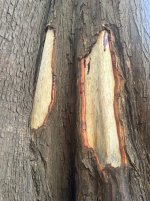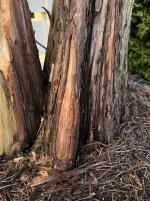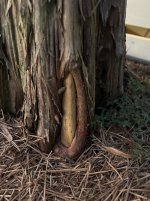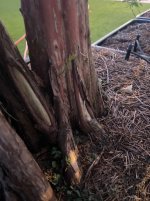BillsBayou
Chumono
This morning, I received a call from someone with the LSU AgCenter regarding damage to bald cypress in the Atchafalaya Basin. I keep laughing when I try to say this out loud. I have a bachelors in Computer Science and an MBA. Someone I know referred me to them. The person who contacted me has a Doctor of Plant Medicine degree and nearly 100 papers published. I have a YouTube channel and have written flame wars on Reddit.
The funny thing is, I think I may be able to offer insight.
The good doctor is wondering if the damage is being caused by some sort of pathogen, fish, or terrestrial animal. While I think it could be caused by someone with a cable or a rope.
The damage is roughly 10-feet off the ground, but the area can be flooded at times with at least that much water. Could be beavers, could be bear, could be fish, could be a guy with a 2x4 or a boat.
So, here's the photos. If you have anything to add, please let me know. I'll pass it on (but not so that I take the credit).
This photo has all the clues to tell me the damage is recent and mechanical/physical damage.
Just above the damage on the left, there are some horizontal abrasions. That tells me that the damage is likely physical rather than biological.
The underlying wood is undamaged. That's a quality of bald cypress. Something damages the soft tissues and that comes off.
Calluses in all photos tell me that this is recent and happened around the same time period.
The top of the right-side damage and the bottoms of both scars were damaged with something horizontal. Bald cypress bark does not easily break horizontally. It has a very strong vertical structure. Since the damage is jagged, I don't think this was a sharp implement. Rather, this was something blunt and forceful. Perhaps a floating log, boat, or guy with a rope and a cable winch.
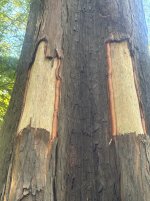
Here, all wounds are in a line. I don't think they all occupy the same plane. Rather, they are unaligned in 2 out of 3 dimensions. I've done similar damage with a rope (but not in the Atchafalaya Basin).
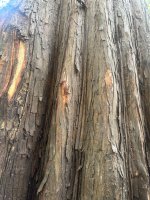
That horizontal cut is just too damned even and jagged to be a biological sign.
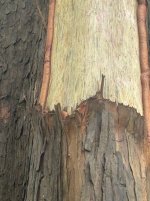
This is narrow damage isolated to the outermost edge of the trunk ridge.
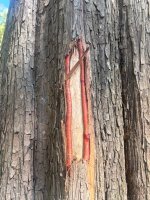
I think I'm laughing from Impostor Syndrome. I do have answers to the problem. It's just that I cannot believe that I've been contacted by people with advanced degrees asking me for help.
Now, if you'll excuse me, I need to go do some severe damage to bald cypress trees. Not this mamby pamby abrading damage but damage that requires me to wear a hard hat and face shield. And, perhaps, have an escape route planned and a lawyer on speed dial.
The funny thing is, I think I may be able to offer insight.
The good doctor is wondering if the damage is being caused by some sort of pathogen, fish, or terrestrial animal. While I think it could be caused by someone with a cable or a rope.
The damage is roughly 10-feet off the ground, but the area can be flooded at times with at least that much water. Could be beavers, could be bear, could be fish, could be a guy with a 2x4 or a boat.
So, here's the photos. If you have anything to add, please let me know. I'll pass it on (but not so that I take the credit).
This photo has all the clues to tell me the damage is recent and mechanical/physical damage.
Just above the damage on the left, there are some horizontal abrasions. That tells me that the damage is likely physical rather than biological.
The underlying wood is undamaged. That's a quality of bald cypress. Something damages the soft tissues and that comes off.
Calluses in all photos tell me that this is recent and happened around the same time period.
The top of the right-side damage and the bottoms of both scars were damaged with something horizontal. Bald cypress bark does not easily break horizontally. It has a very strong vertical structure. Since the damage is jagged, I don't think this was a sharp implement. Rather, this was something blunt and forceful. Perhaps a floating log, boat, or guy with a rope and a cable winch.

Here, all wounds are in a line. I don't think they all occupy the same plane. Rather, they are unaligned in 2 out of 3 dimensions. I've done similar damage with a rope (but not in the Atchafalaya Basin).

That horizontal cut is just too damned even and jagged to be a biological sign.

This is narrow damage isolated to the outermost edge of the trunk ridge.

I think I'm laughing from Impostor Syndrome. I do have answers to the problem. It's just that I cannot believe that I've been contacted by people with advanced degrees asking me for help.
Now, if you'll excuse me, I need to go do some severe damage to bald cypress trees. Not this mamby pamby abrading damage but damage that requires me to wear a hard hat and face shield. And, perhaps, have an escape route planned and a lawyer on speed dial.

